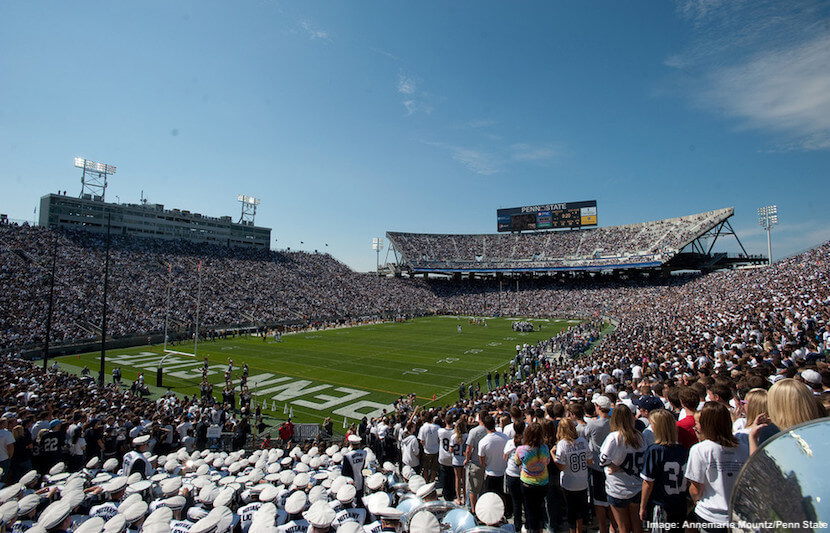Every university strives to increase diversity on its campus. Bringing together people who come from different regions with different experiences allows students to develop empathy skills, critical to success in learning and in life.
Clio Andris, assistant professor of geography at Penn State and lead author of this study, has spent the past several years studying how universities are able to attract athletes from far away.
She determined that college athletics hold a great power to increase diversity on campuses, even for schools in less diverse regions.
“It’s not necessarily a city that pulls people but it’s the colleges and institutions that exist there,” Andris said in a statement. “This research shows that institutions such as universities can bring people to the area from all over the world.”
What she found
Andris and her team looked at more than 20 years of data for 160,000 student-athletes from 1,600 sports teams at 128 different schools.
The researchers determined the distance each athlete traveled and created averages for each school and each sport.
They determined that Ivy League schools attracted the most athletes from far away.
Second to the Ivy League were schools located in more rural areas like the University of Idaho, the University of Arizona and Washington State University.
The results showed that, on average, the greatest number of local athletes are attracted by Northeastern universities.
“I didn’t see that coming,” said Andris.
She also assumed since Idaho is so remote, it would have an isolated, tight-knit group of athletes.
“I was very wrong about that!” said Andris. “I think that the Northeast just has a larger talent pool (population density) nearby. So they simply don’t have to go as far to recruit when there are thousands of high school students.”
Altogether, the researchers found the average distance a student-athlete travels to be 736 miles.
However, that average is diluted by public schools in the Northeast.
Rutgers University, for example, was close to the bottom. Rutgers athletes participating in track and field, baseball and cross country traveled fewer than 100 miles, on average.
In contrast, on average, private schools double that mileage, and athletes at the universities of Arizona, New Mexico and Idaho averaged more than 1,000 miles of traveling.
“If you go to a University of Idaho football game or other sporting event, most of the students on the team are not from Idaho,” Andris said in a statement. “You don’t necessarily think that but if you go to a Rutgers game, the vast majority of the players are from New Jersey. It’s interesting to think about which sports teams are mostly homegrown and which ones are importing their athletes.”
The averages also differed depending on the sport.
Tennis players traveled over 2,000 miles, on average. Those who played specialized sports, such as skiing, swimming and squash averaged over 800 miles of traveling.
The University of Tulsa’s tennis program topped the charts with players traveling an average of 5,000 miles.
Athletic budgets did not seem to correlate to an athlete’s willingness to travel, said Andris.
A paper describing the study is published in the The Professional Geographer.
Motivation for the research
There were multiple factors that motivated the study.
First, Andris wanted to prove that institutions played a role in bringing migrants from diverse places, not just the city.
“Secondly, I was interested in looking at universities not as a product of their admissions test scores or some other ‘US News and World Report’-type ranking criteria, but the experience students would have with diversity at the schools,” said Andris.
“A part of college is meeting new people, listening to different viewpoints and learning about global cultures. I wanted to know which schools had more diverse student bodies — in the absence of this information — I turned to sports rosters.”
Third, she was interested in the ability of public universities to develop a homegrown team.
“There’s a certain passion when you grow up loving a team, and then you get to play for them!,” said Andris. “Fifty or even 100 years ago, I’d guess that state school teams were comprised mostly of in-state students. I wanted to know to what extent this persisted in the 21st century.”
What’s next?
In the future, the researchers are interested in gathering data on entire college campuses.
Currently, they are using Twitter and talking to admission offices about their spatial trends over time, said Andris.
However, this could be a difficult task.
“For public schools, it’s a complicated balance between taking in-state and out-of-state students,” said Andris.
For private schools, the number of international students has grown tremendously in recent years, but this may be due to the rise of online applications.



